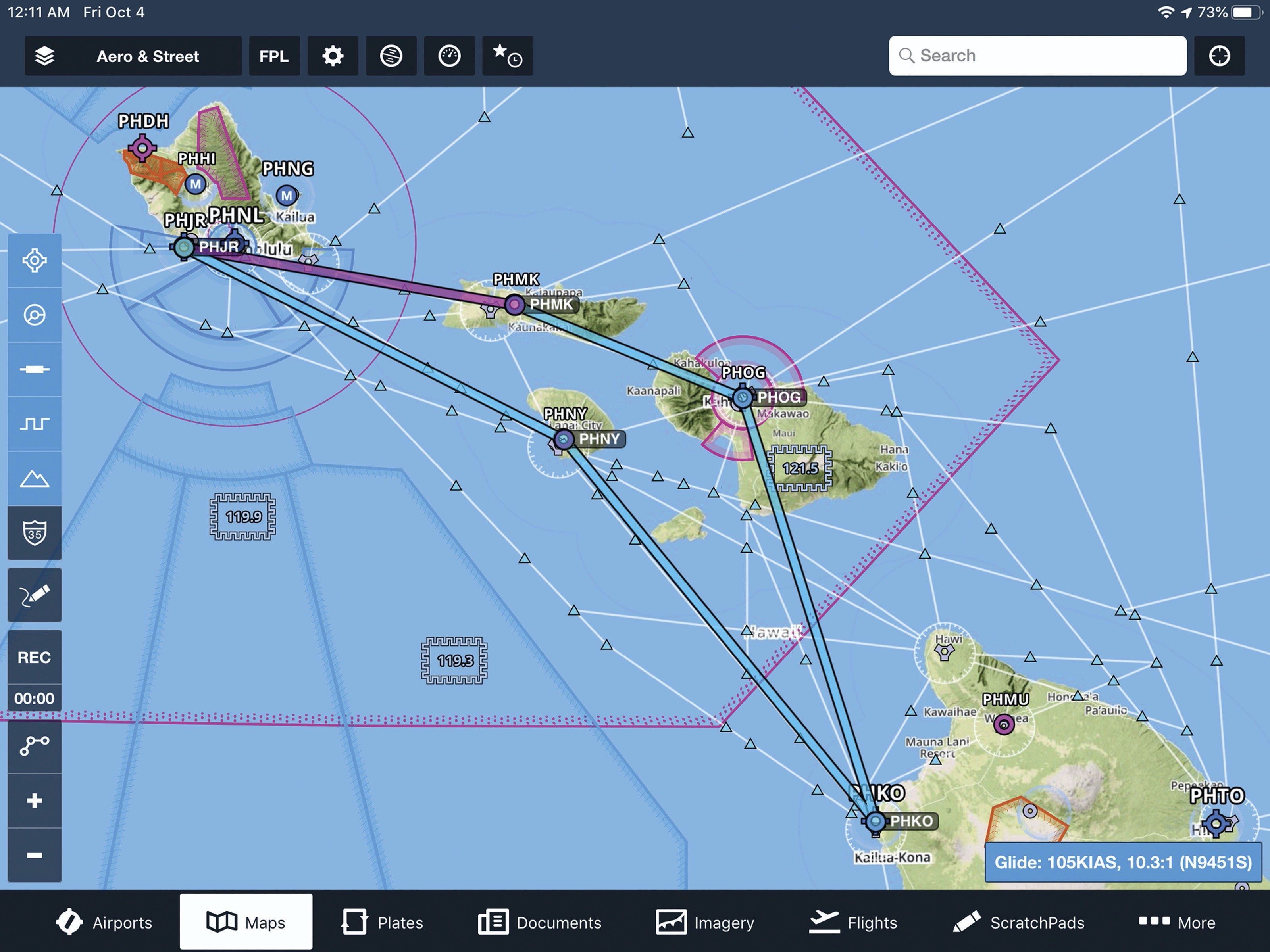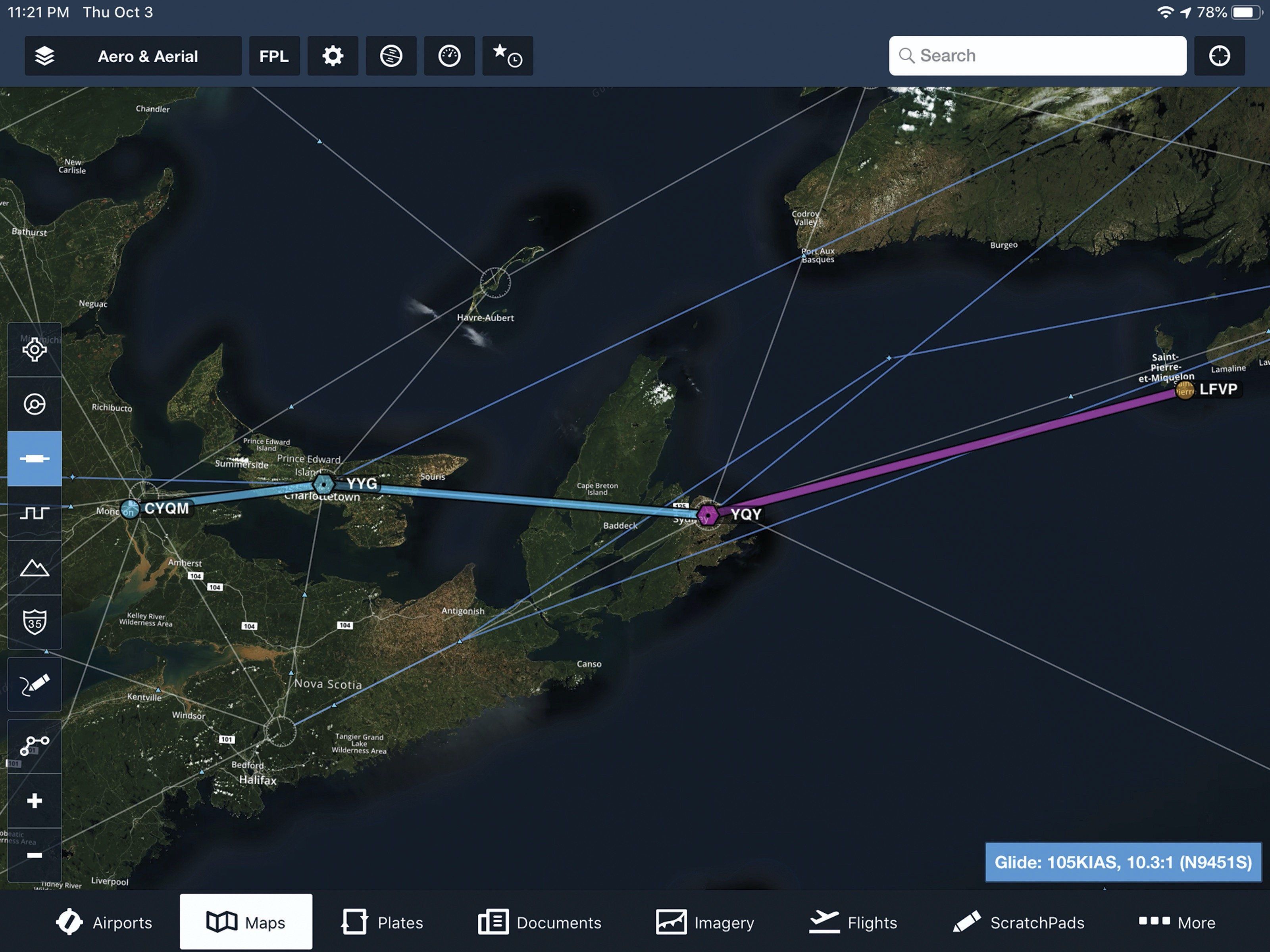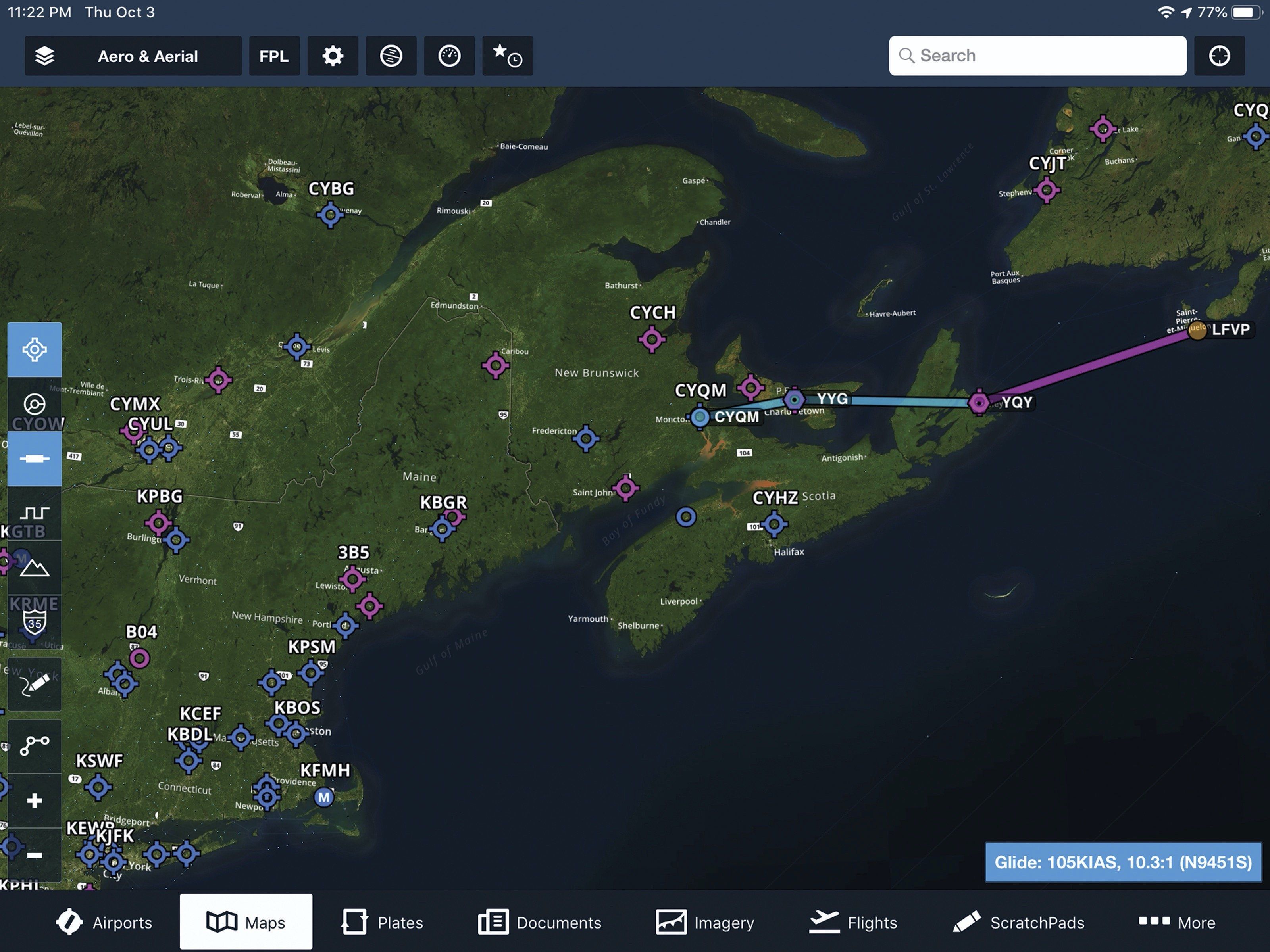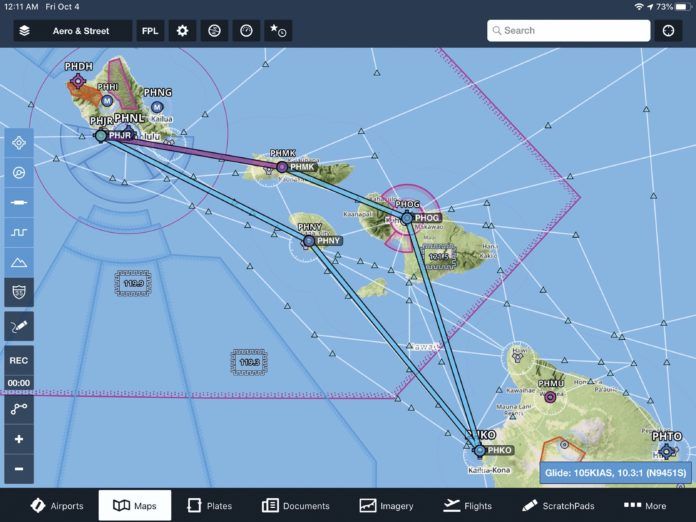It’s an aviation clich that your single engine goes into “automatic rough” when crossing any significant body of water. To be sure, any engine problem while beyond gliding distance from land is a critical problem, even if you have more than one. When flying a single, it’s everything. Another clich is that most of us don’t bother to analyze the real risks of overwater flying. Any water crossing of any significance—and we’d put the Great Lakes, Hawaii and Bahamas in that basket—should be carefully planned to ensure risks are mitigated to acceptable levels. The thing is, both clichs are true more often than not.
Let’s be clear: Transoceanic flight in a small general aviation aircraft is beyond this article’s scope and deserves a series of articles on its own. Nor are we concerned with small lakes or inland bodies of water since their risks blend into general risk management hazards and practices. We’ll briefly look at water survival techniques in the sidebar on the opposite page, another topic deserving detailed treatment. But what we really want to do is discuss identifying and managing overwater risks when doing so isn’t common for our operations. We’ll look at some real-world examples I‘ve experienced over the years, and we’ll find I haven’t always practiced what I preach.

Aircraft-related risks
Let’s deal with the most obvious hazard and risk first. If you’re flying a single-engine airplane over water, the powerplant’s reliability should be foremost in your mind. Most pilots understand this intuitively, but few of us usually take the time to analyze the actual risk level for single-engine operations. For a detailed discussion, see “The Real Risks of Engine Failures” in the November 2018 issue. As with any formal risk management analysis, we should run through an assessment matrix like the one at the top of the opposite page to analyze what is probable, occasional, remote or improbable. Risk severity ranges from catastrophic to critical, then on to marginal or negligible. Let’s look at severity first.
A ditching will usually result in a hull loss, so the risk severity is catastrophic right out of the box. Risk likelihood, on the other hand, is more complex. If you’re flying a single-engine turbine, the likelihood of an engine failure is arguably highly unlikely to occur and hence improbable. Thus, we might assign the overall risk for a turbine single as only “Medium,” and thus acceptable to most of us.
The situation for a piston single is more challenging. An engine failure with a piston single arguably is unlikely, but is still possible. Call it less unlikely than with the turbine single. We would normally classify it as “Remote.” The matrix classifies this risk as “Serious” and thus should be mitigated. This will be a judgment call for some pilots, since it’s not a “High” (red) risk that by good practice must be mitigated. So where does that leave most of us that fly piston singles only and are conservative with our risk management practices? Should we avoid flying over significant bodies of water altogether?
Some pilots would adopt that attitude, and that’s their prerogative, but this also is where basic risk mitigation techniques can be put to practical use. For example, we can reduce the likelihood of engine failure by following rigid preventive maintenance schedules. We can make sure we won’t run out of fuel on our overwater foray. We also can reduce the severity of an engine failure over water by flying high enough to glide to a suitable site on dry land, or follow a coastline just offshore.
How far out can we go before we can’t glide back to land? Your airplane’s documentation should have some kind of glide performance data in it you can use to calculate how many miles you can glide from selected altitudes. A 1978 Mooney M20J 201 I owned (I own a 1990 model now) theoretically could glide engine-out from 11,000 feet MSL for about 24 statute miles before reaching sea level.
It doesn’t take much math to figure out I could cross a body of water 48 miles wide and still make it to land if the engine quit at the exact midpoint. Of course, to get optimum glide performance, you need to use the recommended speeds, which usually assume zero wind and pulling the prop control back to low RPM, minimizing drag. If you’re gliding into a headwind, you’ll need to increase gliding speed slightly, and with a tailwind you’ll need to use a slightly slower gliding speed. You probably have an EFB that will do all of this for you except pull the prop back and pitch for the desired airspeed. Of course, you could accept a “wet footprint” of some sort and count on the engine running during that period. The odds remain in your favor.
The other option is to accept the risk of an engine failure outside of gliding distance to land and the resulting ditching. Again, the odds favor you, even in a piston single, but you still need to consider the mitigations available.
First and foremost, you should have life jackets for all aboard (and wear them while crossing the water), a suitable raft for everyone that is easily accessible and at least one personal rescue beacon. You also should consider the suitability for ditching of the aircraft you are flying. The greatest complications from ditching will occur with a fixed-gear, high-wing single. The biggest problem is whether you can escape from this aircraft after ditching, particularly if it flips over. The easiest ditching will likely occur in a retractable low-wing single. In this best-case scenario, egress can be dicey, even presuming a textbook ditching and no injuries. It’s hard enough getting out of my Mooney under normal circumstances, especially from the rear seats, let alone during a ditching.
Those are your two basic choices: Either plan to glide to land after an engine failure over water or ditch and accept the need to carry appropriate equipment as well as the risk of not getting out of the sinking airplane. You’ll lose the airplane, but your chances of survival may be acceptable.
About 35 years ago, my awareness of all these factors was not as complete as it is now. The sidebars on this and the opposite pages highlight a couple of events that I managed to complete without complications despite my incomplete risk analysis for the flights. Yes, these two jaunts were conducted well before formal risk management processes were identified for typical general aviation operations, and I relate them now to illustrate the kinds of things I didn’t really think too much about back then, but do now.
In hindsight, I would have added a raft and a personal locator beacon. However, I was in constant contact with ATC and local search and rescue resources were readily available if we had experienced a problem.
Environmental risks
Besides the open water combined with the risk of engine failure, there are other environmental hazards and associated risks that we face on all flights, even if we’re not over water. These include fog and very low ceilings, convective activity, airport and airspace issues, and other hazards. When mitigating these risks, keep in mind that, unlike in the Lower 48, there may not be a close diversion airport that you can easily reach in a timely manner. You should plan accordingly and carry enough fuel to get to a multiple number of diversion airports.
You shouldn’t be discouraged about overwater flights if you carefully analyze the risks involved and treat them with the respect they deserve. If you really want to tackle overwater flying but aren’t sure how to manage the risks, I hope the foregoing provides some ideas of what to do and, especially, what not to do. Look beyond this article to the many other sources of information available on overwater flights to popular destinations. Meanwhile, follow these tips to get you started on this process.
• Conduct a thorough risk analysis before attempting any overwater flight.
• Choose the right aircraft for your trip. For many locations, just about any GA aircraft could be suitable. Make sure it has enough range to provide good margins for possible diverts.
• Always carry adequate survival gear. At a minimum, this would include life jackets, a raft and a personal locator beacon.
• Be prepared to delay or even cancel a trip if your risk analysis yields “High” (red) risks that can’t be mitigated.
My risk management awareness is now very well-tuned, I think, and I even assess risk every time I fly around Puget Sound, which is right outside my window. I still can’t decide if it meets my criteria for a “small” body of water or a “significant” one. Therefore, I err on the side of caution and think risk management when flying beyond the shoreline over the Sound.
Risk Assessment Matrix | ||||
| Likelihood | Severity | |||
Catastrophic | Critical | Marginal | Negligible | |
Probable | High | High | Serious | Medium |
Occasional | High | Serious | Medium | |
Remote | Serious | Medium | Medium | Low |
Improbable | Medium | Medium | Medium | |
Water Immersion Without Exposure Suit | ||
| Temperature (F) | Exhaustion or Unconsciousness | Expected Survival Time |
70-80 | 3-12 hours | 3 hours-indefinitely |
60-70 | 2-7 hours | 2-40 hours |
50-60 | 1-2 hours | 1-6 hours |
40-50 | 30-60 minutes | 1-3 hours |
32.5-40 | 15-30 minutes | 30-90 minutes |
< 32 | < 15 minutes | < 15-45 minutes |
Water Temperature Is a Crucial Factor
If you end up in the water after an emergency, your survival will depend on a lot of factors, and the water’s temperature will be perhaps the most important one. According to most sources, water temperature below 70 degrees F will present an immediate survival issue. Breathing can be affected at 77 degrees and below. Temperatures between 60 and 70 are dangerous, while temperatures from 50-60 are life-threatening for humans without any exposure protection. Anything below 50 degrees means we may be talking about minutes. The following chart gives you some idea of how much time you have in the water before exhaustion, unconsciousness and survival. We’ll refer to this chart as our discussion proceeds.
There are a couple of other factors to keep in mind about water survival. For example, swimming or treading water greatly increase the body’s heat loss and can decrease your survival time by more than 50 percent. However, even just floating motionless in a life jacket is no answer either, since cold water robs the body’s heat at a rate 32 times that of cold air. Clearly, it’s essential to long-term water survival to have some exposure protection, such as a raft. Data in the table below are from the U.S. Search and Rescue Task Force.
Leaving Too Much To Chance?

It was February 1972, and I was tiring of the long Montana winter as I sat in my Minuteman missile launch center waiting for Armageddon. My friend in the Navy flew P-3s out of Barbers Point in Hawaii and told me the weather was much better there. It didn’t take much urging for me to hop on a C-135 headed west.
After a couple of raucous party nights (the Navy bests the Air Force in this category), I checked in to the Barbers Point Aero Club with my letter of good standing from the Vandenberg AFB Aero Club. In no time at all, I had completed the formalities and was issued a Cessna 150 and a life jacket, and told to enjoy myself. At this time, I had about 760 hours total time and had just added instrument and multiengine ratings to the commercial certificate I earned in college. I thought that was enough experience to prepare me for anything. It turned out I was wrong. Nevertheless, I knew what I wanted to do and had planned a long day trip to five of the eight major islands in Hawaii using the route shown above.
It would be easy to use the risk assessment matrix to identify all the risks I blithely assumed that day. There probably were no “High” (red) risks, but there were enough “Serious” (yellow) ones to warrant mitigations I did not exercise. I flew as high as the 150 would go on the way to the Big Island, but I was still out of gliding range of land for a long period.
I didn’t carry a raft or locator beacon. Presuming I could escape from the high-winged, fixed-gear 150 after a ditching, I would have a long wait in the water until my flight plan expired or someone responded to my Mayday call on the way down. All and all, it was a good example of poor risk management. Having survived this experience, I went on to even more interesting overwater excursions, as detailed in the sidebar on the opposite page.
Glide to…where?
In August 1984, I flew my Mooney and some friends to France…. When the British ejected the French from North America in 1763, they allowed France to retain two small islands off the coast of Canada’s Newfoundland Province. Saint Pierre and Miquelon have remained a province of France and are part of the European Union.
We departed Montpelier, Vermont, for Moncton, New Brunswick, where we cleared Canadian customs. We then flew on to St. Pierre. It was solid IFR all the way, but we were on top at 11,000 feet, per the forecast. We never saw Newfoundland and ended up shooting the ILS at St. Pierre to minimums. Fog persisted the entire three days we were there and, on the return flight, we were in IMC most of the way. At our 12,000-foot cruising altitude, the outside temperature was just above freezing. We carried no life jackets, or any other survival gear except a bag of some really good croissants.
Canadian regulations at that time required that we carry life jackets unless we were within gliding distance of shore. Our ace in the hole was a small island between Cape Breton Island in Nova Scotia and the southwest tip of Newfoundland, St. Paul Island. It’s so small it’s not on the charts at right, but I calculated we could “glide” to it if the engine quit. It turns out my ace was just a big rock with many trees and no real place for a soft landing. The summer water temperatures in the Gulf of St. Lawrence are in the low 50s. That doesn’t sound promising. Dumb, huh?

Robert Wright is a former FAA executive and President of Wright Aviation Solutions LLC. He is also a 9900-hour ATP with four jet type ratings and he holds a Flight Instructor Certificate. His opinions in this article do not necessarily represent those of clients or other organizations that he represents.




